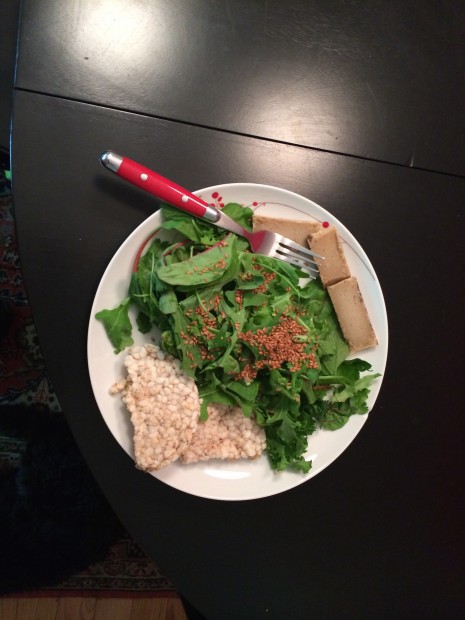Every year around this time, lots of people are trying to eat better, lose some weight, and generally get their act together. But maybe we’re looking at the food thing wrong: instead of focusing first on eating healthy, let’s think about eating happy. While there isn’t universal agreement on this, there is compelling evidence to suggest that many of the foods we think of as producing health may produce happiness, too.
The majority of foods believed to be mood-boosters are what vegans consume as a matter of course: complex carbohydrates, leafy greens, other richly-colored vegetables, and fruits, nuts and seeds. The brain chemical most often credited for feelings of contentment and wellbeing is serotonin. More serotonin is synthesized as the amino acid tryptophan enters the brain, so one would think that consuming more high-protein foods – protein is made up of amino acids, after all – would pave the highway to happiness, but that’s not the case.
You can think of tryptophan as kind of shy and retiring, not an amino acid to aggressively push itself from bloodstream to brain as many of the others are wont to do. Eating more carbohydrates – and we’re talking nature’s carbs: vegetables, legumes, whole grains, fruit — appears to enable more tryptophan to get into your brain.

Serotonin production is also aided by:
- B-complex vitamins. Whole grains are rich sources overall. Folate and vitamin B12 are believed to play a role in warding off depression, some types of dementia, and central nervous system maladies. Get folate from greens (i.e., foliage – the vitamin and its foremost source share a root) and beans, rather than from its artificial form, folic acid, which may encourage the develop of breast cancer. Some plant-based foods – nondairy milks, most brands of nutritional yeast flakes, some breakfast cereals – are fortitied with vitamin B12, but you’re supplementing anyway to be sure you’re on the safe side.
- Vitamin D. Get it from sunshine and supplements (look for a vegan vitamin D3). Individual needs vary widely; get your levels checked by your doctor.
- Omega-3 fatty acids. Flax, walnuts, savi seeds, chia, and kiwifruit are plant sources of ALA, which the body can convert into the usable forms of omega-3, DHA and EPA. Since it’s uncertain how well this conversion happens in a particular individual, many physicians and dieticians recommend taking algae-based DHA/EPA supplement providing 300 mg. of DHA (the amount of EPA doesn’t matter so much, since ALA converts to it more easily).
The trace mineral selennium is another good-mood nutrient, shown to improve mild-to-moderate depression. This masterful antioxidant and anti-inflammatory is found in whole grains, beans, and nuts and seeds, especially Brazil nuts. Nutrition guru Michael Greger, MD, recommends twenty-two Brazil nuts a month to meet selennium needs – you can either pop one a day, or make Brazil nut milk (delicious!) every couple of weeks
Several studies imply that eating breakfast – pretty much any breakfast, it appears – leads to more vitality throughout the day, greater calmness, and even a better memory. If you include a banana, you’re getting B6, whch boosts production of dopamine, another feel-good brain chemical, and magnesium, a mineral believed to contribute to an upbeat attitude. Add blueberries or blackberries and let their anthocyanins, the antioxidants belied by the berries’ rich color, further aid the production of dopamine.
Brain Bummers
Just as some foods and the chemicals in them can apparently lift our mood, others can cause it to tank. The stuff of food porn – trans fats, articifical colors and sweeteners, MSG – have all been implicated as contributing to a foul mood and irascibility, one more reason to avoid eating anything too many steps removed from nature. And alcohol, despite its ability to produce short-term feelings of confidence and sociability, is actually a depressant to the brain and nervous system. In this case, moderation rules.
Saturated fat – found primarily in animal foods, but also in coconut, palm oil, and cocoa butter — may also play a role. The Coronary Health Improvement Project, which looked at 348 men and women aged twenty-four to eighty-one, determined that a decrease in dietary sat-fat was associated with a decrease in depression – and it took only six weeks’ time. Perhaps due to saturated fat, or simply a dearth of carbohydrate, a traditional Atkins-style diet sabotages serotonin. An Arizona State University study determined that only two weeks on such a program increased subjects’ fatigue levels and decreased their desire to exercise, a known mood-booster in itself.
Gluten, the protein in wheat, rye, spelt, barley, and some other grains, is known to inhibit serontonin production. These foods, and gluten itself, sometimes called seitan, are useful dietary additions for many people, but some folks are allergic to gluten (that’s called celiac disease), and others expereince varying degrees of “feeling off” when they eat gluten-containing grains. If you feel better, in your tummy or in your attitude, without wheat and its cohorts, let them go. The plant kingdom is almost infinite in its offerings: there’s lots more out there to eat.

Victoria Moran is the founder and director of Main Street Vegan Academy. Her next book, The Good Karma Diet: Eat Gently, Feel Amazing, Age in Slow Motion, will be published in May.

